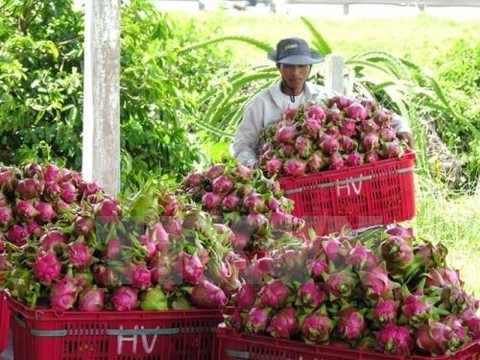Agro, forestry, seafood exports up
 |
| In 2017, the export value of fruit and vegetable reached a record US$3.5 billion, a year-on-year growth of 43.02 per cent. - VNA/VNS Photo |
The export of major agricultural products was estimated at $18.96 billion, a year-on-year growth of 15.7 per cent and that of seafood at $8.32 billion, 18 per cent higher than last year. The export value of forestry products in 2017 was estimated at $7.97 billion, an increase of 9.2 per cent year-on-year.
The nation also saw strong growth in rice exports in December with a volume of 426,000 tonnes worth $199 million. Total rice exports for the year reached 5.89 million tonnes, earning $2.66 billion, a year-on-year surge of 22.4 per cent in volume and 23.2 per cent in value.
China continued to be the largest buyer of Vietnamese rice, accounting for 39.5 per cent of the total exports.
Rubber, tea, cashew nuts and other produce also saw high growth in 2017.
In 2017, rubber exports reached 1.39 million tonnes worth $2.26 billion, a year-on-year increase of 11 per cent and 35.6 per cent, respectively, in volume and value.
Average rubber export price for 11 months stood at $1,654.7 per tonne, up 28.3 per cent over the same period in 2016. China, Malaysia and India were the three largest rubber buyers.
High prices pushed cashew nut exports to 353,000 tonnes worth $3.52 billion, a year-on-year increase of 1.9 per cent in volume and 23.8 per cent in value. The US, the Netherlands and China were top importers.
This year, the export of tea was estimated at 140,000 tonnes worth $229 million, up 7.2 per cent in volume and 5.6 per cent in value over last year.
Exports of cassava and cassava products were estimated at 3.95 million tonnes in volume and $1.04 billion in value for a year-on-year surge of 6.9 per cent and 4.2 per cent, respectively.
However, coffee exports decreased slightly by 20.2 per cent in volume to 1.42 million tonnes and 3.8 per cent in value to $3.21 billion. Germany and the US were still the top two export markets for Vietnamese coffee.
There was a strong reduction in pepper exports in 2017 because export prices fell sharply by 35 per cent over the previous year. While pepper export volumes surged by 20.5 per cent to 214,000 tonnes, its value fell 21.9 per cent to $1.12 billion, compared to 2016.
Vegetables, fruits
The ministry said that in 2017, fruit and vegetable exports also reached a record $3.5 billion for year-on-year growth of 43.02 per cent.
Top 10 export markets for Vietnamese vegetables and fruits in 2017 included mainland China (75.6 per cent), Japan (3.64 per cent), the US (2.94 per cent), South Korea (2.59 per cent), the Netherlands (1.81 per cent), Malaysia (1.43 per cent), Taiwan (1.33 per cent), Thailand (1.03 per cent), UAE (1.01 per cent) and Russia (0.85 per cent). Other markets accounted for 7.77 per cent, according to vneconomy.vn.
In addition to traditional markets, Vietnamese fruit has managed to enter demanding markets like the US, European Union, Japan, Canada, Australia and New Zealand.
Nguyen Huu Dat, general secretary of the Viet Nam Vegetables and Fruits Association, said vegetable and fruit exports continued its strong growth in value this year, exceeding the export value of some key export products like rice, oil and gas.
He said that in 2018 and further, besides improving the quality of vegetables and fruits, enterprises need to focus on processing as a way to add value and extend exports throughout the whole year, not just during specific seasons.
Dinh Cao Khue, general director of the Dong Dao Food Export Joint Stock Company, said processed fruit products have prices 10-20 times higher than that of fresh fruit.
Enterprises can only select 40-50 per cent of harvested vegetables and fruits for export on quality considerations, so the remaining quantity should be processed to get higher value from them, he added.
What the stars mean:
★ Poor ★ ★ Promising ★★★ Good ★★★★ Very good ★★★★★ Exceptional
Latest News
More News
- Bespoke policies to fast-track key developments in Hanoi (December 06, 2025 | 11:40)
- Can Tho poised to become Mekong Delta growth engine (December 05, 2025 | 18:09)
- Quang Trach I thermal power plant races towards completion (December 05, 2025 | 13:56)
- Vietnam targets higher value chains as global production reshapes (December 05, 2025 | 13:54)
- Hanoi and Mekong Delta set for major boost as new infrastructure projects break ground (December 05, 2025 | 13:42)
- Coro Energy to launch BESS Pilot in Vietnam (December 04, 2025 | 15:12)
- Amata City Ha Long fosters collaboration with Chinese manufacturers (December 04, 2025 | 15:07)
- Phu Tho accelerates industrial growth as post-merger economy gains momentum (December 04, 2025 | 11:45)
- Education reforms aid dealmaking appeal (December 03, 2025 | 10:07)
- Manufacturing deals bring stronger supply chains closer (December 03, 2025 | 09:34)

















 Mobile Version
Mobile Version